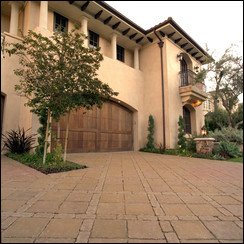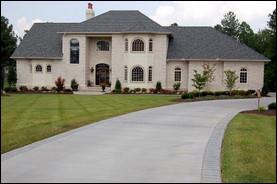 A pervious concrete driveway absorbs water instead of shedding it. If a municipality has tight environmental regulations for residential construction, this type of driveway may be required. Photo courtesy of Gordon Kenna, Georgia Concrete and Products Association. |
Most homeowners think of driveways as little more than a necessity. When it comes time to select one, usually the main consideration is installation and maintenance cost. But today, homeowners have a host of choices to dress up their driveway. Here are a few of the most common.
Asphalt
Asphalt, also known as blacktop, has traditionally been the material of choice for most homeowners because it’s the least expensive option, it doesn’t show stains and, if properly maintained with sealing, it should last for 15 to 20 years. It’s also a good choice for colder climates because it’s petroleum-based and it expands and contracts with freezing and thawing temperatures, which reduces cracking. For those in hotter climates, asphalt is less desirable.
“It’s a softer material,” says Rich Napier, president of Richmond, Va.-based Napier Signature Homes. “You need to compact it really well, and you can run in to problems with sinking areas. We run into that with pavers, too. They get little ruts in them from the cars’ wheels.”
Another asphalt option is macadam, also called tar and chip. It’s a combination of hot, liquid asphalt and crushed stone, topped with a very thin layer of colored stone to fill in any voids. One of the benefits of these driveways is they take on whatever color of stone or gravel you mix in with the asphalt. They also offer traction in icy conditions, and they don’t show stains. It’s less expensive than an asphalt driveway, but has a shorter lifespan—expect to resurface every six to 10 years.
 A concrete driveway edged with pavers is an elegant and durable entry for a home. Photo courtesy of Napier Signature Homes. |
Concrete
Concrete is a more expensive, but more permanent, driveway surface. A mixture of Portland cement, water, crushed stone and sand, concrete driveways can last for 30 years or more, according to the Skokie, Ill.-based Portland Cement Association. Properly cured and sealed to protect against stains and repeated thawing and freezing, they’re virtually maintenance-free except for a good cleaning and sealing once every four to five years. The options are extensive, including colored, engraved and stamped concrete, which can resemble stone, brick, cobblestones or even wood planks. The big drawbacks are the cost and cracking, which are nearly inevitable. Napier says that many of his customers like to “mix and match” driveway materials, such as stamped concrete, pavers, cobblestones or pea gravel.
“A trend now for green building is, instead of doing an entire driveway out of concrete, we may border the driveway in stamped concrete with a paver pattern down the middle with grass or gravel in between so water soaks in instead of running down,” he says.
 Pavers can give an Old World look to new construction. Photo courtesy of Systems Paving, Inc. |
Another green option is pervious concrete, which absorbs water. With the right design, a pervious driveway will store as much as six inches of rainwater that will drain into the underlying soil instead of running down the street, says Gordon Kenna, executive director of the Tucker, Ga., based-Georgia Concrete and Products Association.
Pervious driveways aren’t difficult to install, Kenna says, but proper design is essential to achieve the correct drainage. Also, the material is “very, very different” from regular concrete and will probably cost 20 to 25 percent extra, he cautions. “It’s made with a specialty aggregate,” he says. “Most concrete producers can secure it but won’t have it on-site.” It is much dryer than regular concrete and needs to be raked into place, compacted with a roller and immediately covered with plastic for a week to keep the water in the cement from evaporating. Otherwise, “you get a lot of loose stones,” Kenna says. Maintenance is easy: Sweep or blow it off like any other driveway.
Pavers
Pavers are an ancient surfacing choice with a reputation for durability. Whether they’re made of concrete, brick or natural stone, pavers are one way to avoid the cracking that comes with concrete because they’re installed individually.
“They don’t fail because they’re basically a pre-cracked driveway,” says Doug Leuck, a partner with Systems Paving in Newport Beach, Calif., which manufactures and installs interlocking paving stoves. “The product we install is a manufactured product out of concrete, but the concept has been around since the Romans. Some of those roads are still there today.”
 Imagination is the only limit to the designs that can be incorporated into a driveway done with pavers. The ring pattern shown here around a pool area is popular in driveways as well. Photo courtesy of Systems Paving, Inc. |
As with concrete, pavers can come in a wide array of colors and patterns. Most people opt for a simple design that complements the colors and architectural style of their home. Others, however, use it to make a major statement. “We’ve inserted Olympic rings, a basketball, a Christmas tree, roses, even a dollar sign,” Leuck says.
Another benefit of pavers is that they’re ready for use as soon as they’re installed as there is no curing time during which it can’t be walked or driven on. And if a repair is ever needed, it’s a fairly easy process to remove the damaged section and replace it.
The biggest drawback of pavers is the expense. Leuck estimates that his product costs about three times as much as asphalt and at least twice as much as plain concrete. The primary reason for the cost difference is the labor involved to set each piece. That’s why many of Napier’s customers use pavers as decorative accents in a concrete driveway.
There’s also a risk of the pavers sinking if they’re not properly installed, and Napier says he sometimes gets complaints about weeds growing in between them.
Like most driveways, pavers need to be properly maintained. They should be sealed at least every two years to prevent water damage and staining.
Credit: Renovate Your World





























Thanks so much for talking about the maintenance of concrete driveways. My parents want to repave their driveway and are trying to choose between asphalt and concrete. Knowing the concrete is almost maintenance-free makes it appealing for homeowners who don’t have a lot of time on their hands.